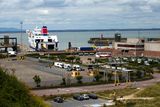Brendan Keenan: Asking if there is a property bubble is the wrong question
Enda Kenny - even asking the right question does not guarantee the right answer
The Irish Question was very difficult, according to an old joke. Every time the British found the answer, the Irish changed the question. That was the political question we are supposed to have finally answered 20 years ago this year, with the IRA ceasefire.
To paraphrase Zhou Enlai, it may be too early to say. But the Irish economic question is exhibiting the same symptoms. Just as we seemed to successfully negotiate the Crash, the question changed.
Or rather, an old question re-appeared. Is the economy, and particular the property market, in danger of overheating? Should the government be taking steps to cool it - even, merciful hour, increasing stamp duty on buy-to-let properties in Dublin, as suggested last week by Frank Quinn of Blackrock Further Education Institute? There is no doubt that things are moving at extraordinary speed. One set of good statistics follows another. Tax revenues soaring, unemployment tumbling.
Just five years after what may have been the worst banking crash ever recorded in a rich economy, the most common concern in public discourse is whether another bubble is blowing. Before trying to answer that, one really has to ask if it is the right question.
Further examination closed the jaw pretty quickly. It turned out that the Swords queue was small, and the houses didn't all sell anyway.
Asking whether another bubble is inflating is almost certainly the wrong question. Fretting about the causes of past crashes is a common reaction which has often prevented people seeing the next, different set of problems looming up.
It is gratifying that we are already in a position where the challenges of the future are more urgent than cleaning up the mess of the past but it would be foolish to imagine that the past will simply repeat itself.
Even in larger economies, the speed of downturns catches those who come in late or stay in too long, while recovery is always a surprise, even if a welcome one. In Ireland these phenomena are even more pronounced.
Having said that, we have not enjoyed the unmistakeable "V" shaped recovery which was the subject of much discussion at the start of the Crash. It is more the "U" shaped variety typical of financial busts.
The recovery is already two years old, but that had largely gone unnoticed. It is only now that the upward curve of the "U" is becoming apparent, and causing some consternation.
The overall picture emerges in last week's PMI survey of managers in services. The sector has experienced 25 successive months of expansion in business activity.
This came hard on the heels of CSO figures showing a 20pc surge in industrial output in the 12 months to July. Services firms saw an increase in new business at home and abroad. Some found credit for new projects easier to attain - a response borne out by Central Bank data on lending.
The impact of the external environment may be gauged from the finding that new export business has been expanding for three years, with the US and UK the key sources.
As would also be expected after a financial crash, the upturn has been led by the business sector, not by consumers. The impact of a multi-national companies selling more computer services to Britain would not be widely apparent beyond the economic statistics. This helps explain the varied reactions to the recovery - that there is no such thing; that it is confined to Dublin; and that it is a property bubble.
Recovery means different things to statisticians and ordinary people. The former are dealing with that slippery concept, growth, which merely tells you that things are better than they were in the previous period. The latter may well feel that recovery means their lost income and wealth has been restored. That is a very different matter, and a much, much slower business.
It is quite wrong to regard the fact that it has not yet happened as some kind of failure - even more to claim there is no recovery. Although what exactly is going on, is far from clear - even this Dublin v. the Rest business.
"Dublin" would have to be widely defined. Figures to July showed the strongest employment growth was in the mid East region, and the Midlands did pretty well too. Yet the regions with the worst employment results, the Mid West and South West, recorded the biggest falls in the Live Register last month - down 10pc. Another question is to what extent market forces and migration should be allowed to do their work in this way, or whether policy interventions should try to create employment in different areas.
The biggest question of all is also the great unanswered one - how to maintain a stable economy within the Eurozone. Already we see the Irish carriage being tugged along by the British and American locomotives, while the Euro engine remains stuck in the siding.
The inherent volatility of the Irish economy is exacerbated by the euro; the currency of a region with which it has limited connections.
Politicians have shown scant regard for stability down the years: research has convincingly shown that their policies have consistently increased volatility. Those habits, when combined with euro membership, spelt disaster.
They could so so again, unless habits change. If our leaders wish to remain in the euro without repeating these disasters, they will have to devise national strategies to deflate bubbles when conditions are too favourable, and alleviate downturns when conditions are hostile.
There may be no immediate danger of a bubble - although Mr Quinn could have a point about curbing property investment when there are negligible returns on most traditional assets. Trouble, though, could come sooner - before we are in a position to deal with it: what price Scottish independence, followed by British (including Northern Ireland) exit from the EU?
It is something that Michael Noonan is talking up the virtues of stability. Barring accidents such as referenda, a gradual recovery would allow, as a starter, the creation of stability funds to be raised during good times and spent in bad.
The structural balance in the new EU rules, although extremely nebulous in Ireland's case, is the right kind of target.
Mr Noonan mentioned the Nordic countries as an exemplar. One cannot disagree, in that, unlike us, they take such matters seriously.
But I could not help but notice, in the last ESRI quarterly, that two countries with higher house price ratios than Ireland in 2006 were Denmark and Norway.
Even asking the right question does not guarantee the right answer.
Join the Irish Independent WhatsApp channel
Stay up to date with all the latest news














